High-Efficiency Polarization-Independent LCoS Utilizing a Silicon-Based Metasurface
Abstract
1. Introduction
2. Design Principle
3. Experimental Results and Discussion
3.1. Fabrication and Optical Property Measurement
3.2. Phase Response Measurement
3.3. Fringing Field Effect Analysis and Beam Steering
3.4. Processing Tolerence
4. Conclusions
Author Contributions
Funding
Institutional Review Board Statement
Informed Consent Statement
Data Availability Statement
Conflicts of Interest
References
- Vettese, D. Liquid crystal on silicon. Nat. Photon 2010, 4, 752–754. [Google Scholar] [CrossRef]
- Zhang, Z.; You, Z.; Chu, D. Fundamentals of phase-only liquid crystal on silicon (LCOS) devices. Light Sci. Appl. 2014, 3, e213. [Google Scholar] [CrossRef]
- Lazarev, G.; Chen, P.J.; Strauss, J.; Fontaine, N.; Forbes, A. Beyond the display: Phase-only liquid crystal on Silicon devices and their applications in photonics [Invited]. Opt. Express 2019, 27, 16206. [Google Scholar] [CrossRef]
- Fernández, E.J.; Prieto, P.M.; Artal, P. Wave-aberration control with a liquid crystal on silicon (LCOS) spatial phase modulator. Opt. Express 2009, 17, 11013–11025. [Google Scholar] [CrossRef] [PubMed]
- Yamaguchi, K.; Otomo, K.; Kozawa, Y.; Tsutsumi, M.; Inose, T.; Hirai, K.; Sato, S.; Nemoto, T.; Uji-i, H. Adaptive Optical Two-Photon Microscopy for Surface-Profiled Living Biological Specimens. ACS Omega 2021, 6, 438–447. [Google Scholar] [CrossRef]
- Fernandez, E.J.; Suchkov, N.; Artal, P. Adaptation to the eye’s chromatic aberration measured with an adaptive optics visual simulator. Opt. Express 2020, 28, 37450–37458. [Google Scholar] [CrossRef]
- Eguchi, A.; Brewer, J.; Milster, T.D. Optimization of random phase diversity for adaptive optics using an LCoS spatial light modulator. Appl. Opt. 2019, 58, 6834–6840. [Google Scholar] [CrossRef]
- Guo, X.; Liu, Y.; Yin, T.; Morrison, B.; Pagani, M.; Daulay, O.; Bogaerts, W.; Eggleton, B.J.; Casas-Bedoya, A.; Marpaung, D. Versatile silicon microwave photonic spectral shaper. APL Photonics 2021, 6, 036106. [Google Scholar] [CrossRef]
- Hasegawa, S.; Hayasaki, Y. Femtosecond laser processing with adaptive optics based on convolutional neural network. Opt. Lasers Eng. 2021, 141, 106563. [Google Scholar] [CrossRef]
- Han, Z.; Yan, B.; Qi, Y.; Wang, Y.; Wang, Y. Color holographic display using single chip LCOS. Appl. Opt. 2019, 58, 69–75. [Google Scholar] [CrossRef] [PubMed]
- Yu, N.; Genevet, P.; Kats, M.A.; Aieta, F.; Tetienne, J.P.; Capasso, F.; Gaburro, Z. Light Propagation with Phase Discontinuities: Generalized Laws of Reflection and Refraction. Science 2011, 334, 333–337. [Google Scholar] [CrossRef] [PubMed]
- Zhang, C.; Hu, J.; Dong, Y.; Zeng, A.; Huang, H.; Wang, C. High efficiency all-dielectric pixelated metasurface for near-infrared full-Stokes polarization detection. Photon. Res. 2021, 9, 583–589. [Google Scholar] [CrossRef]
- Zhang, Y.; Wu, Z.; Xia, J.; Wu, J.; Yang, K.; Dong, C.; Tong, G.; Zhang, H.; Yang, R.; Luo, Y. Infrared metasurface absorber based on silicon-based CMOS process. Opt. Express 2022, 30, 32937–32947. [Google Scholar] [CrossRef]
- Lin, Y.H.; Ren, H.; Wu, Y.H.; Zhao, Y.; Fang, J.; Ge, Z.; Wu, S.T. Polarization-independent liquid crystal phase modulator using a thin polymer-separated double-layered structure. Opt. Express 2005, 13, 8746–8752. [Google Scholar] [CrossRef]
- Moore, J.R.; Collings, N.; Crossland, W.A.; Davey, A.B.; Evans, M.; Jeziorska, A.M.; Komarcevic, M.; Parker, R.J.; Wilkinson, T.D.; Xu, H. The Silicon Backplane Design for an LCOS Polarization-Insensitive Phase Hologram SLM. IEEE Photonics Technol. Lett. 2008, 20, 60–62. [Google Scholar] [CrossRef]
- Zhu, Z.; Wen, Y.; Li, J.; Chen, Y.; Peng, Z.; Li, J.; Zhu, L.; Wu, Y.; Zhou, L.; Liu, L.; et al. Metasurface-enabled polarization-independent LCoS spatial light modulator for 4K resolution and beyond. Light Sci. Appl. 2023, 12, 151. [Google Scholar] [CrossRef] [PubMed]
- Anderson Keith, J.M.M. Reflective LC Devices Including Thin Film Metal Grating. U.S. Patent 10,473,839 B2, 12 November 2019. [Google Scholar]
- Sakhare, P.A.; Atmakuri, M.; Dontabhaktuni, J. Tailoring the resonant modes in liquid crystal based all-dielectric metasurfaces. Sci. Rep. 2023, 13, 6780. [Google Scholar] [CrossRef]
- Gelbart, W.M. Molecular theory of nematic liquid crystals. J. Phys. Chem. 1982, 86, 4298–4307. [Google Scholar] [CrossRef]
- Ramachandran, G.N.; Ramaseshan, S. Crystal Optics; Springer: Berlin/Heidelberg, Germany, 1961. [Google Scholar]
- Liu, T.; Yang, S.; Tang, D.; Da, H.; Feng, R.; Zhu, T.; Sun, F.; Ding, W. Polarization conversion based on an all-dielectric metasurface for optical fiber applications. J. Phys. D Appl. Phys. 2017, 50, 334001. [Google Scholar] [CrossRef]
- Tkachenko, V.; Abbate, G.; Marino, A.; Vita, F.; Giocondo, M.; Mazzulla, A.; Ciuchi, F.; Stefano, L.D. Nematic Liquid Crystal Optical Dispersion in the Visible-Near Infrared Range. Mol. Cryst. Liq. Cryst. 2006, 454, 263–271. [Google Scholar] [CrossRef]
- Xu, L.; Zhang, J.; Wu, L.Y. Influence of phase delay profile on diffraction efficiency of liquid crystal optical phased array. Opt. Laser Technol. 2009, 41, 509–516. [Google Scholar] [CrossRef]
- Lee, K.B.; Cheon, S.; Kim, C.O. A Convolutional Neural Network for Fault Classification and Diagnosis in Semiconductor Manufacturing Processes. IEEE Trans. Semicond. Manuf. 2017, 30, 135–142. [Google Scholar] [CrossRef]
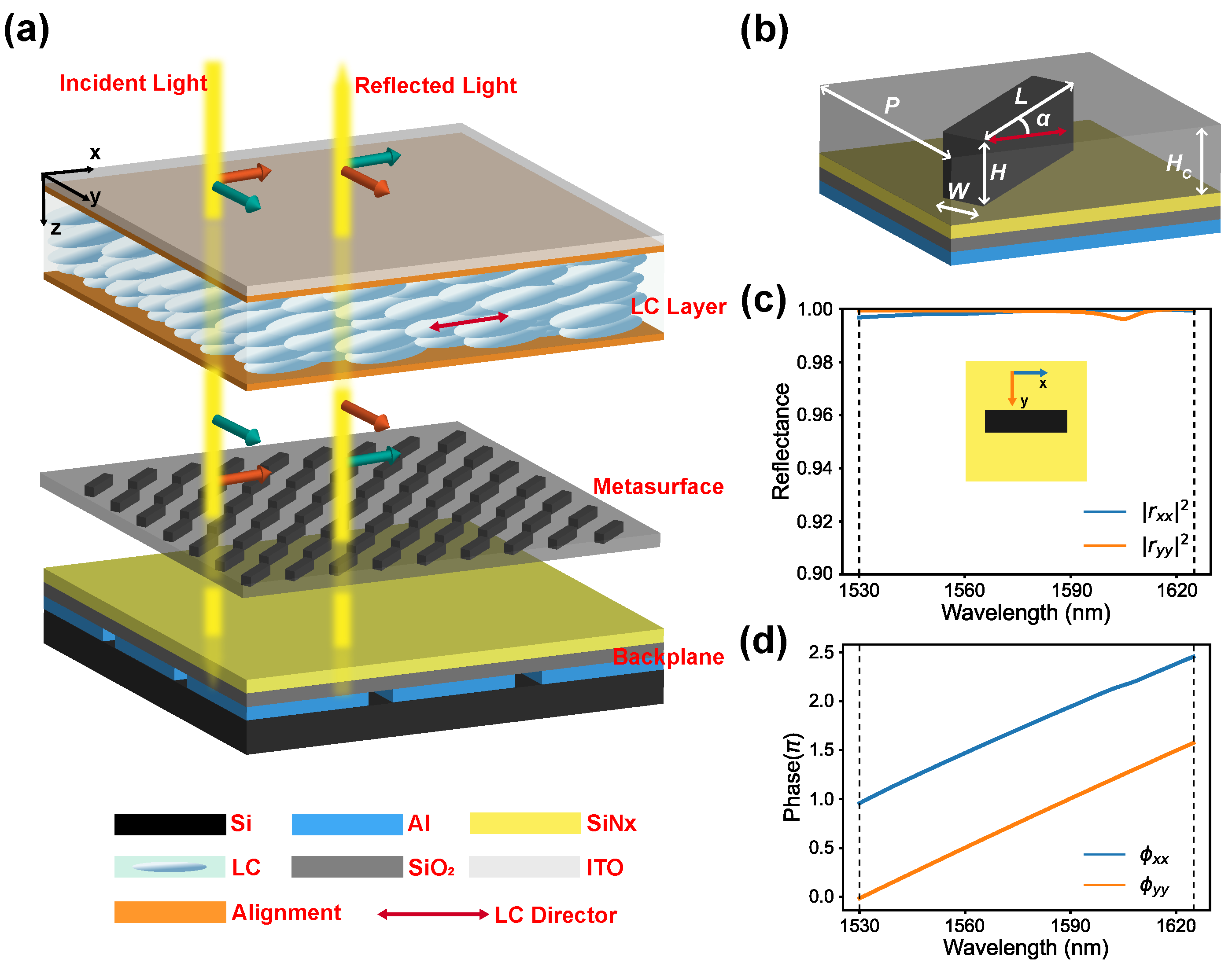
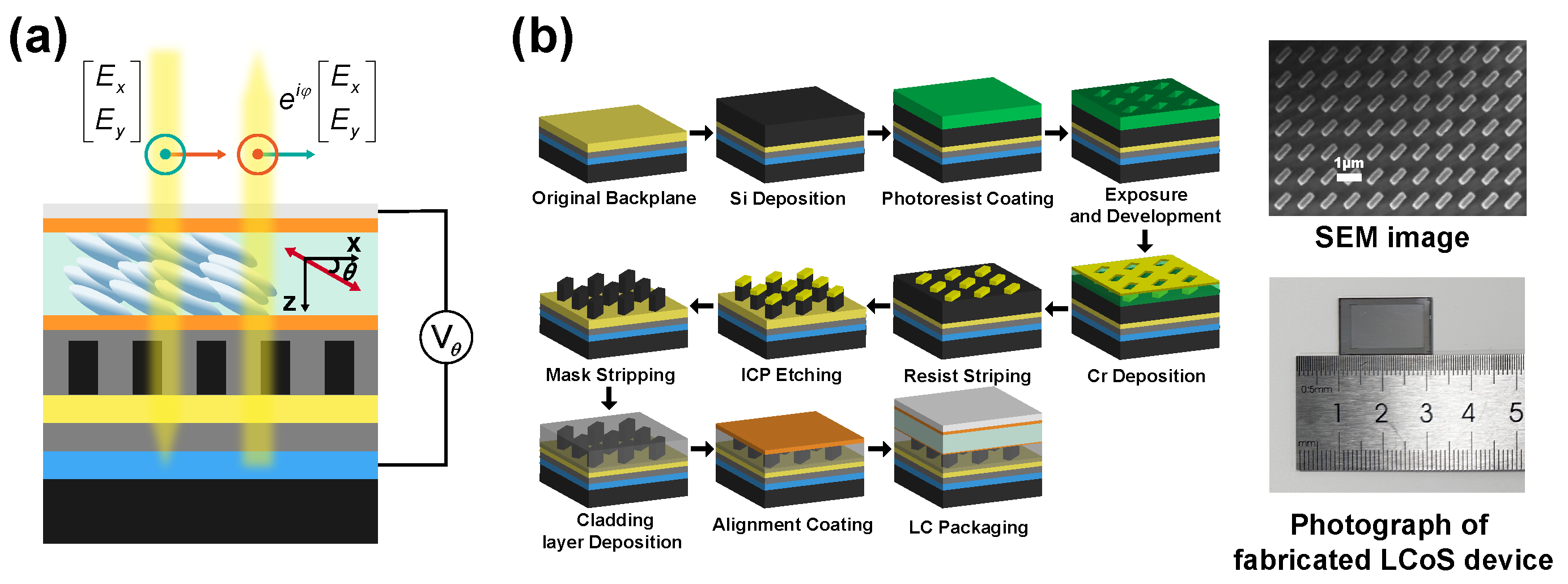
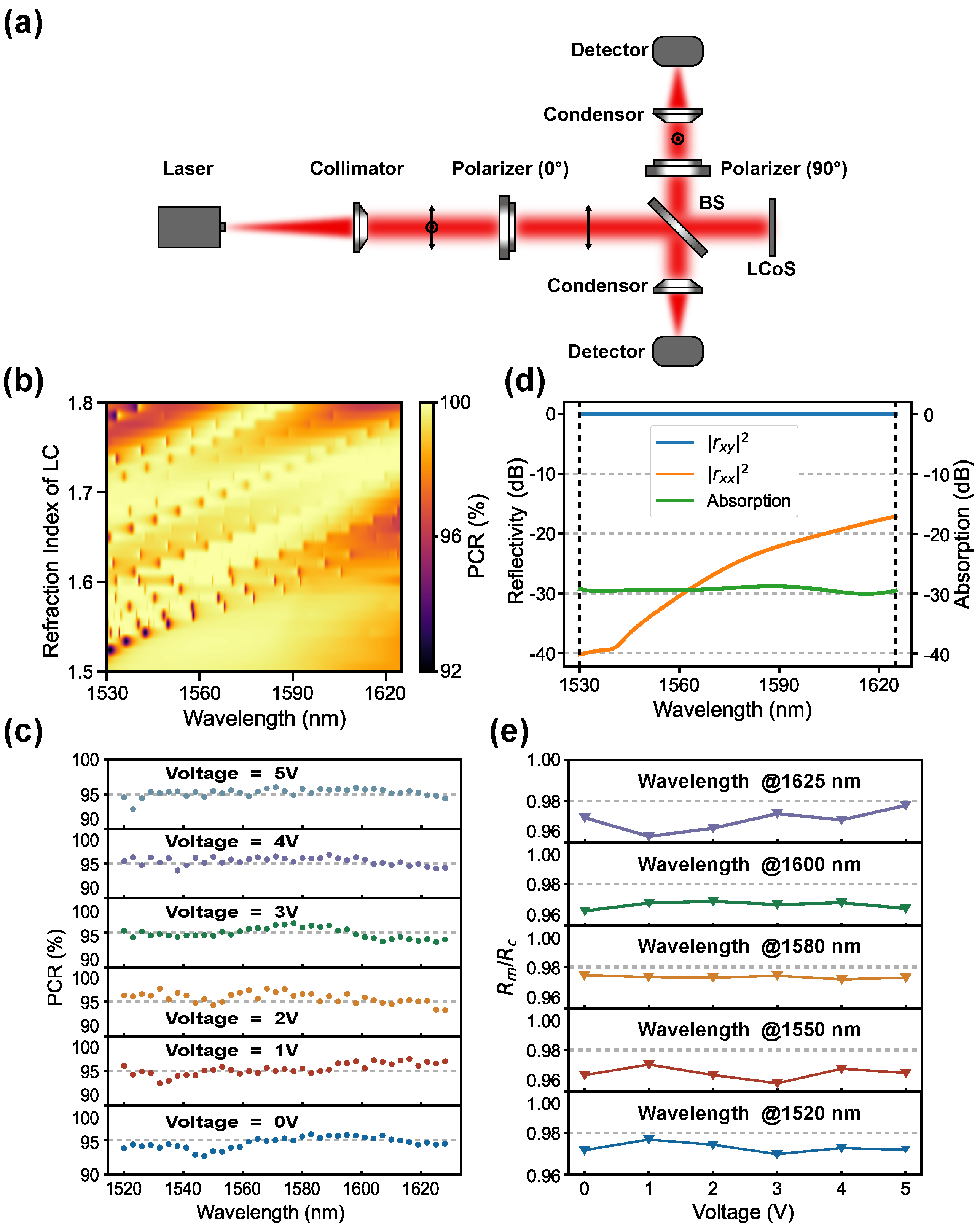
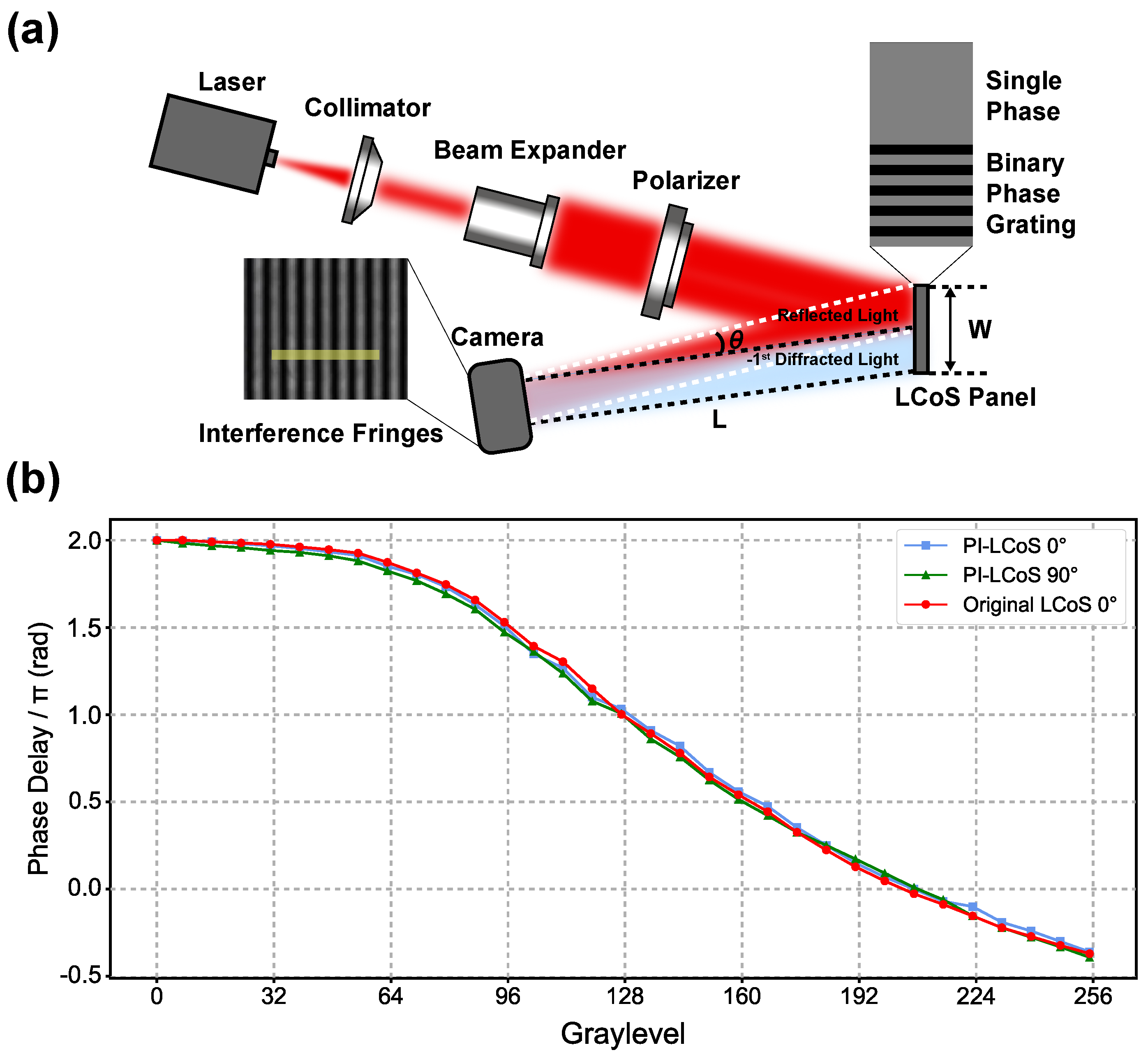
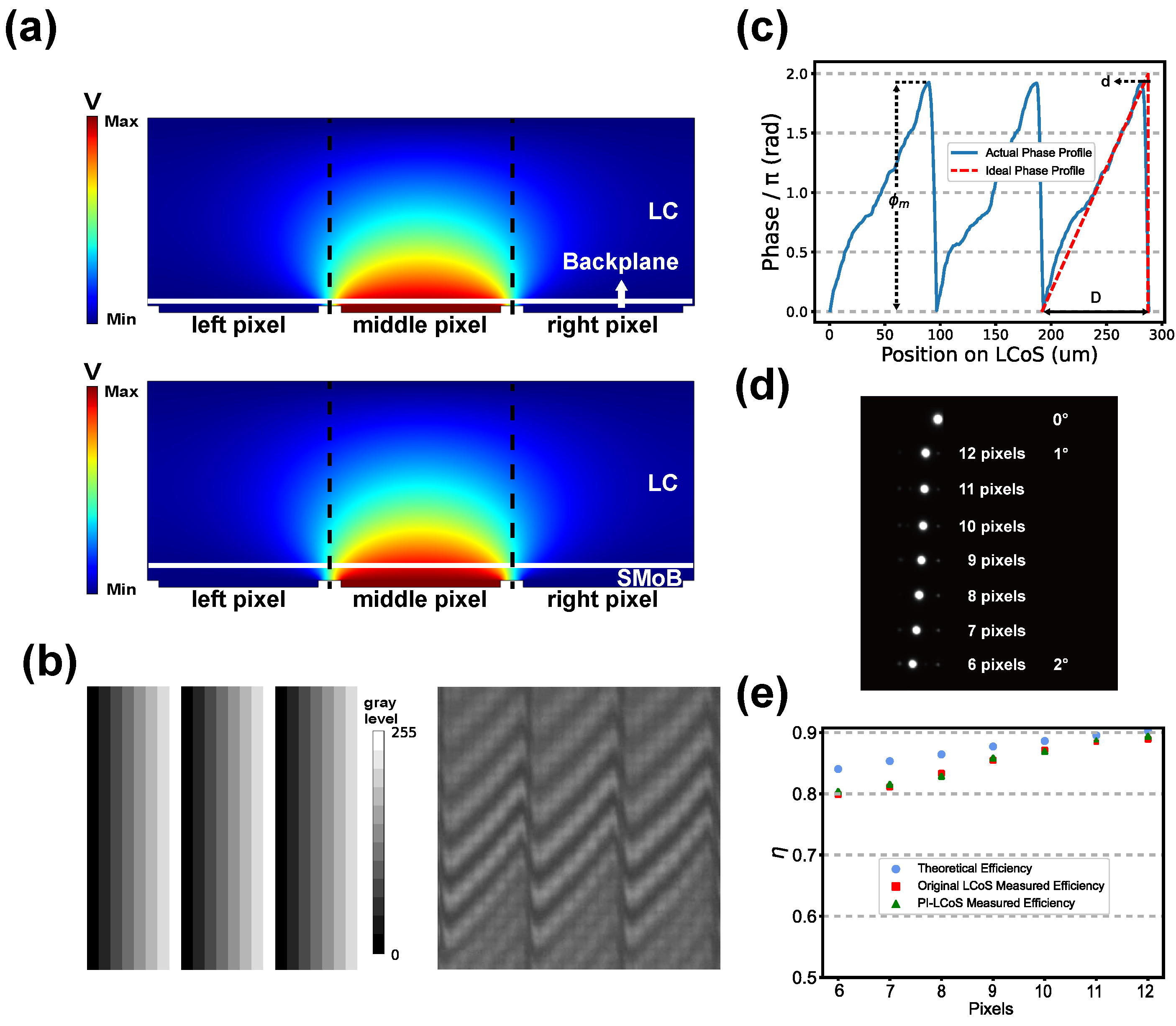

Disclaimer/Publisher’s Note: The statements, opinions and data contained in all publications are solely those of the individual author(s) and contributor(s) and not of MDPI and/or the editor(s). MDPI and/or the editor(s) disclaim responsibility for any injury to people or property resulting from any ideas, methods, instructions or products referred to in the content. |
© 2025 by the authors. Licensee MDPI, Basel, Switzerland. This article is an open access article distributed under the terms and conditions of the Creative Commons Attribution (CC BY) license (https://creativecommons.org/licenses/by/4.0/).
Share and Cite
Deng, Y.; Liu, B.; Yan, J. High-Efficiency Polarization-Independent LCoS Utilizing a Silicon-Based Metasurface. Photonics 2025, 12, 552. https://doi.org/10.3390/photonics12060552
Deng Y, Liu B, Yan J. High-Efficiency Polarization-Independent LCoS Utilizing a Silicon-Based Metasurface. Photonics. 2025; 12(6):552. https://doi.org/10.3390/photonics12060552
Chicago/Turabian StyleDeng, Yuxi, Boyun Liu, and Jinhua Yan. 2025. "High-Efficiency Polarization-Independent LCoS Utilizing a Silicon-Based Metasurface" Photonics 12, no. 6: 552. https://doi.org/10.3390/photonics12060552
APA StyleDeng, Y., Liu, B., & Yan, J. (2025). High-Efficiency Polarization-Independent LCoS Utilizing a Silicon-Based Metasurface. Photonics, 12(6), 552. https://doi.org/10.3390/photonics12060552



